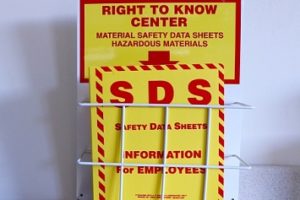Obtaining and managing updated safety data sheets (SDSs) is one of the top 3 challenges facing respondents to BLR’s 2017 Hazard Communication Survey. What would make an environment, health, and safety (EHS) manager’s job easier when it comes to managing SDSs? Here are 5 tips that may not have occurred to you.
According to BLR’s 2017 Hazard Communication Survey, 53% of the respondents said that obtaining and managing updated SDSs was a significant challenge.
Note: 2012 amendments to the Hazard Communication Standard, which adopted the Globally Harmonized System of Classification and Labelling of Chemicals (GHS), in part, specifies the format and required content for SDSs.
According to the 2017 survey, half of the respondents (46%) still use paper-based binders to manage their SDSs. In addition, 52% of the survey takers use a system that does not have the capability to provide them with access to GHS-updated SDSs.
Tip 1: Don’t Just Slap It in a Binder
If you have workers who use, or may use, a hazardous chemical at your facility, you must obtain the SDS for the chemical from the chemical manufacturer, importer, or distributor. Use, in this context, means to package, handle, react with (such as introduce into a process), or transfer a hazardous chemical.
You must also ensure that the SDS is available to your workers. If, for some reason, an SDS is not included in a shipment labeled as a hazardous chemical, you must request and obtain it as soon as possible.
You can’t just take the SDS from the manufacturer, importer, or distributor and slap it in a binder. Someone must be responsible for reviewing it. While you are not technically liable for the accuracy of the SDS supplied by a manufacturer, importer, or distributor, you are required to have accepted the SDS in “good faith”—that is, without blank spaces or obvious inaccuracies. You must report inaccurate or missing information on an SDS to the chemical manufacturer or distributor. In order to do that, someone has to review the SDS.
This even includes an SDS received from the manufacturer, importer, or distributor that has a different responsible party name than that on the product label. You must make a documented good-faith effort to receive the appropriate SDS. So, whoever reviews the SDS should also take a look at the product label.
If you request an SDS or a corrected SDS and don’t receive it, contact your local Occupational Safety and Health Administration (OSHA) area office for assistance in obtaining the SDS.
If an OSHA inspector goes through your SDSs and pulls any with inaccurate or missing information, you should have the documentation that you contacted the manufacturer or distributor.
Tip 2: Don’t Mix Your SDSs
OSHA can be persnickety. You must have the specific SDS for the specific chemical you got from a specific manufacturer or importer. You can be cited for maintaining one SDS for a particular chemical but using that same chemical from a different manufacturer or importer. You must obtain and maintain the SDS from the new manufacturer or importer.
Tip 3: MSDS v. SDS—You May Have a Mix
However you choose to manage your SDSs, you must have the most current version, and your workers must have immediate access to that version.
By June 1, 2015, chemical manufacturers, importers, or other employers responsible for preparing SDSs must have formatted each SDS using consistent headings in the specified 16-section sequence. As of that date, you should no longer be receiving material safety data sheets (MSDSs).
Is it an MSDS or an SDS? You are required to keep the most current version of the SDS from the manufacturer of the chemical present in the workplace—it may be an MSDS for chemicals shipped before June 1, 2015.
Each (M)SDS must be retained at the worksite for as long as the hazardous chemical is used at the worksite. It is OK if you have MSDSs on file for shipments of hazardous chemicals you received before June 1, 2015.
Tip 4: Technically Modern? You May Have a Problem
According to the BLR 2017 Hazard Communication Survey, top methods for accessing SDSs include (some workplaces use more than one method):
- Hard copy (68%)
- PC, kiosk, or laptop (60%)
- Mobile device such as a laptop or smartphone (19%)
Being up to date from a technology standpoint has its good points and bad points for managing SDSs at your workplace. According to OSHA, if you are maintaining SDSs on a company website or with an off-site/Web-based SDS service provider that faxes them, you must maintain a backup procedure or system (e.g., paper, another electronic system) for accessing SDSs in case the on-site electronic SDS management system fails.
There may be no barriers to immediate worker access to an SDS. An electronic system failure is considered a barrier if there is not a backup system in place.
In addition, you may not require workers to do an Internet search or have to ask for an SDS if you do something like store the SDSs in a locked office.
Tip 5: You Can’t Be Forced to Be Technologically Savvy
Manufacturers, importers, and distributors may not force you to accept SDSs electronically. This is an “opt-in” system. You must agree to the use of electronic distribution no matter how you are going to manage SDSs in your workplace.
If you initially agreed to receiving SDSs electronically, you may opt-out of the system any time. The manufacturer, importer, or distributor must provide by nonelectronic means or a hard copy of the SDS with the next shipment after the “opt-out” and whenever the SDS is updated. Along those same lines, you may request a hard copy of a particular SDS any time you want one.
Remember, you must train your workers on how to access SDSs at your facility. Check tomorrow’s Advisor for some tips to help your workers understand and access SDSs.

